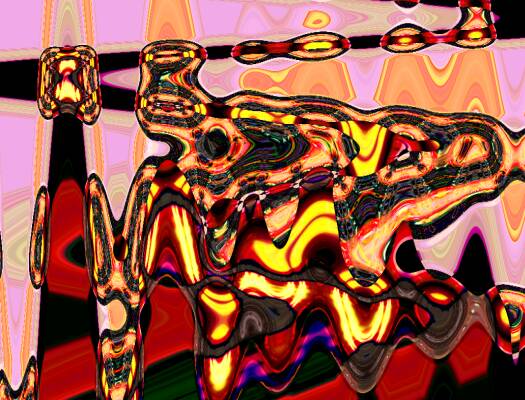

Art by Norman E. Masters
Someday, if you have not already, you will realize that everyone is crazy. Being crazy is not a problem. Pain and suffering are problems. Crazy is someone's unique point of view. One's personal perspective is the product of their experience. A mind organizes, categorizes and assigns significance to stimulations of the body's senses. No two minds being alike, everyone's point of view is unique.
Standing in the summer sun I comment, "It is hot." My friend believes he knows what I mean, but his experience of "hot" is distinct from mine. My discomfort may center on thirst while his centers on perspiration. He may be wishing for a cool breeze while I want an iced tea. Since he hates tea, when I tell him what I want to cool off with he might say, "You're crazy."
Being "crazy" does not hurt unless others punish you for being yourself. To be "crazy" is not the same thing as having a mental illness. Seeking distinctiveness is normal. Adolescence is a time of life when individuals seem to strive for "crazy" as they seek to establish an identity different from that of their family members and from adult authority figures like teachers and such. As one secures a sense of separation, however, a growing sense of isolation is generated.
A rising fear of being alone resonates with primitive survival mechanisms and emotional memories from infancy. Angst, coupled with ambiguous libidinal impulses that genome replication imperatives generate, produces a patterned behavior identifying one with micro and macro cliques and other pseudo societies formed in preadult years. During this period of life, to be "normal" means you cannot simply be yourself. You must be a Teen. "Teenness" sets your style. Your values merely mirror the minds of minions motivated and manipulated by the bodacious among them, and by a marketplace that seeks to exploit Teens' revenue. You are less yourself than you were when, as an infant, toddler and child, parental aspirations and apprehensions prescribed your identity.
Some young people, not captured by the current pop quasi-culture characterizing their age caste, find escaping from mental anguish more necessary and more difficult. Their peers do not merely ostracize them. They torment them. The psychological scar tissue created from continuous conflict with peers and adults during these formative years exacerbates their uniqueness in adulthood. Proscribed peculiar, they are then denied ordinary opportunities to obtain the symbols of success, profession, house, spouse and progeny, accessible to the average adult seeking to establish their image and social status.
Among these outcasts are the 1 percent of the entire population whose experiences can be officially designated as symptomatic of psychoses. Neurological anomalies that limit an individual's ability to identify incongruities in their conceptual processes, such as between visualization and imagination or between actual reality and perceived reality, are the distinctions defining disorders. The problem facing the other-than-ordinary, whether psychotic or not, is not the loss of the material dream.
The goals of most so-called normals are phantoms. They confine their consciousness to adolescent delusions, images assembled from a childhood's perspective distorting perception of the adult world. As parents, addicted to these illusions, they exaggerate the significance of their seemingly superior stature. They lord over their progeny, accessing things denied to children and enforcing rules from which they are excluded, thus inculcating an envisaged potential for the presence of power and privilege, and for the need to secure evidence of them, into emerging psyches as essential indices of identity.
Those whose attention is not focused on the pursuit of symbols are more likely to recognize opportunities to access their Spiritual essence. Sadly, a language that can express this intuitive aspect of their being, in terms that they can cognitively grasp, is seldom available. While many religions and philosophies speak of a Soul, few articulate an image of the source of an individual's true reality. Seekers of dimensions that transcend physical and temporal limitations will be challenged to discover notions, ancient or modern, that are congruent with their vague visceral sense of who and what they are.
We who are crazy enough to believe that we are on The Path are usually rebuffed by others when we foolishly attempt to share our beliefs. The normal know the "real world" and we do not live in it. Even other seekers, focused solely on that part of Truth they are in contact with, often reject another's insight when no obvious connection with their knowledge is evident. How can "it" be both a tree trunk and a rope? The majority, seeking a good life, are seldom bothered with profitless motives to do good. With God safely corralled in a church of their choice, or dismissed as an outmoded notion, pleasure is the measure.
Gorge and purge, regurgitate and regorge. Consumption proves worth. Pursue happiness and leave your pain behind. "Forget your troubles, come on get happy" and "Don't worry, be happy" are slogans successful seniors and the nouveau riche would wish all lived by. This madness passes for sanity in most modern societies today, as sophisticates conceptually fracture creation into minutae and rank the fragments as more important than the whole. Does it require a greater madness or a relative sanity to believe that everything somehow fits together, each an inseparable part of a continuous flow of contiguous moments? Perhaps a little psychosis necessary before one can ride an elephant.
 |
 |
 |